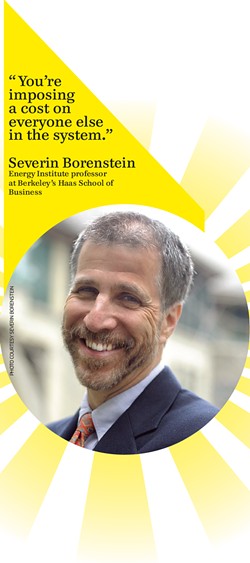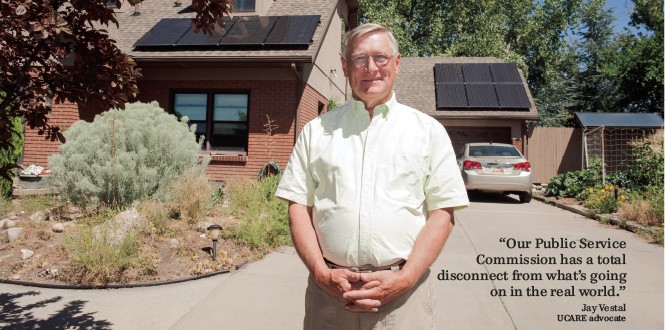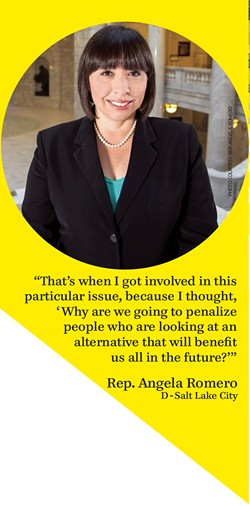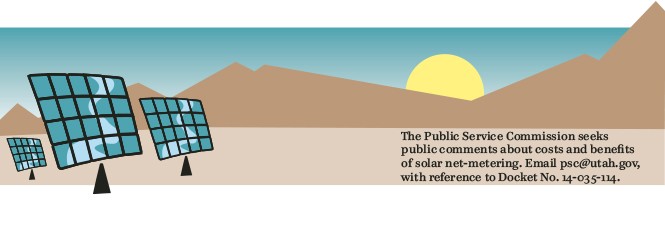Power Struggle
In the solar-panel debate, Rocky Mountain Power turns a blind eye to the environmental benefits of sunshine
By Eric S. Peterson @ericspetersonThis story was updated Aug. 7, 2015
Mark Larsen fits the bill of a stereotypical solar-panel user. He's a semi-retired college Spanish professor, active member of Utah Citizens Advocating for Renewable Energy (UCARE) and lives in a suburb of brown adobe homes outside of St. George. From across the valley, his community blends into the surrounding red rock, like a field of boulders on the beige desert horizon. Since he more or less lives under a sun-baked rock, Larsen decided he might as well soak up the rays and use them to power the three-bedroom home on a half-acre he shares with his wife and a feisty Pomeranian named Tisa (short for Petisa or "petite" in Spanish).
His solar-panel array keeps the home cool, powers his electric car and gives back excess electrons to the grid. Considering the fact that Larsen is such a progressive carbon-footprint-conscious professor, it may come as a surprise that his major beef with Utah's regulated monopoly, Rocky Mountain Power (RMP), is, he says, the company's "socialist" posturing.
The way Larsen describes it, if electrons were wealth, RMP would be the redistributor-in-chief when it comes to skimming clean solar-generated electrons and giving them to customers still reliant on the utility's deep and dirty fossil-fuel energy mix—which, between coal and natural gas, accounts for more than 70 percent of RMP's delivered energy.
"For the last 4 1/2 years, we donate those [extra] electrons to Rocky Mountain Power, and Rocky Mountain Power then turns around and sells them to our neighbors at the full rate, even though they haven't done anything to generate it. Now they want to fine me for making that donation to the grid?" Larsen asks with a scoff.
"They keep up a facade of this socialist appearance in order to maintain their capitalist profit, and to me, that is the last straw," Larsen says.
While the sun shines on us all, the solar-energy debate is one that divides people along class and color lines, oftentimes with proponents of traditional fossil fuels arguing that "net meter" customers—those who power their homes with solar power—have for too long had their costly panels subsidized by average customers. This line of argument goes that "distributed generation" (DG) that results from net-meter (solar panel) customers actually can strain the grid, and the discount those customers receive on their bills is significantly higher than the value of the energy they give back. The "Sunny DG" crowd, however, argues that clean energy returned to the grid profits the utility immediately while providing long-term benefits to the community and the planet overall. According to an outside expert, Severin Borenstein of the Energy Institute at Berkeley's Haas School of Business, both claims are true.
But what's interesting in the current net-metering debate is what's not being talked about: the external environmental and public-health benefits of solar in reducing air, land and water pollution. Currently, the referees in this debate—the Public Service Commission (PSC), which is studying the costs and benefits of solar net metering—have been studying the issue with plans to offer a proposal that would be up for public comment in October.
In 2014, when RMP first floated the idea of a $4.25-per-month tariff on net-meter customers, the utility was battered by negative publicity. Since then, the PSC has made a strong move to block out "externalities" from the debate. The PSC has agreed that, during this phase of the discussion, clean-energy advocates will not be able to argue for the long-term benefits of solar, but will be restricted to analyzing costs and benefits only in terms of rates and utility-infrastructure concerns.
To put it another way, if the regulation debate were a trial, and lawyers for the sun wanted to cross-examine coal for past crimes of pollution and mass assaults on the public's health, RMP would be the lawyer objecting to hearsay, and the PSC would be the judge appointed by Gov. Gary Herbert sustaining the objection.
In Utah, state regulators have set up the analysis now to take "externalities" off the table, but advocates point out that it's still possible for the public to let the commission know they want these factors to be part of the discussion, and that such things can still be presented as an appeal argument when the commission begins debating a "just and reasonable" solar tariff.
There are only an estimated 3,000 rooftop-solar users in Utah, so why is there so much heat over the issue? Solar advocates point out that, left unchecked, the utility will do everything it can to muscle out renewable-energy providers so it can keep burning dirty fossil fuels. For now, solar net-meter customers comprise a small subset of ratepayers, but RMP realizes that they are a rapidly growing demographic. RMP's parent company Pacificorp noted in its 2015 Integrated Resource Plan that, at the end of 2014, it had 8,266 net-meter customers across the six states it operates in—an increase of 48 percent from the previous year.
As for those "external" factors such as air quality and environmental concerns? Larsen, for one, says it shouldn't be hard to bring them into the PSC's calculations. He says that during the four years since he went solar, the reduction in carbon-dioxide emissions from his home and his electric car added up to more than 140,000 pounds of CO2.
"It doesn't take a rocket scientist to look up on the Environmental Protection Agency's website to see how much CO2 is developed by burning a lot of coal," Larsen says.
Solar-Side Economics
The sun business is booming and has, in recent years, presented incredible opportunities as an energy industry. According to a June 2015 report by Environment America Research & Policy Center, by the end of the third quarter of 2015, "21,300 megawatts of cumulative solar electric capacity had been installed around the country, enough to power more than 4.3 million homes." The report congratulates progressive policies that have helped make it affordable for these projects to soak up the sun and pass the savings on to solar customers.
The report cited the standard benefits one would expect: Solar has reduced 71 million tons of carbon emissions since 2007. Buoyed by a drive for cleaner energy, the industry also has helped create a booming workforce—the report cites that, in 2014, the solar-energy industry added jobs at a rate 20 times that of the overall economy. In late July, two separate solar companies announced plans to expand operations in Utah, with expectations to add 7,000 new jobs to the local economy in coming years.
But not everyone is convinced that this booming business is a win for all consumers.
Professor Borenstein says that net metering provides a significant and oftentimes unfair subsidy for customers who decide to go solar.
Borenstein points out that net-meter customers across the country generally reap their rewards in discounts on their bills. If a net-meter customer consumes 100 kilowatt-hours in a month, and generates 30 of those kilowatt-hours from his solar panels, the energy he generates offsets his bill—but at the retail, not wholesale, rate. This, Borenstein says, hurts utilities.
"Most utilities—not all, but with most utilities—their cost of generating a kilowatt-hour is substantially lower than the retail price, because it also pays for things like transmission and distribution costs that are mostly fixed," Borenstein says. So, if the net-meter customer is reimbursed at the retail rate, the utility has to make up the difference somewhere—that is, at the expense of other ratepayers.
"You're imposing a cost on everyone else in the system," Borenstein says.
It's a point echoed by David Eskelsen, a spokesman for Rocky Mountain Power. "The kilowatt-hour charges paid by residential customers are intended to cover fixed costs of the system, not just energy costs that can be avoided by net metering," Eskelsen writes via email.
Borenstein says it can be unfair to customers in states where they don't receive fair compensation for energy generated in excess of consumption. In Utah, RMP customers receive a billing credit for excess energy produced that they can carry over month to month, until March of every year when the credits expire. Generally, Borenstein says, most net-meter customers don't produce more energy than they consume. In sunny California, he says, less than 5 percent of all houses with solar actually generated more than they consumed over a year—still, regulators there recently adopted a system to provide compensation for these excess electrons.
In a recent presentation to Utah state regulators, RMP warned that implementing a two-way flow of power could be costly: For example, line fuses that cost $1,300 which need to be installed at stations throughout the network would have to be replaced with $24,000 line reclosers.
From Borenstein's perspective, there are concrete savings in "distributed generation"—for example, in the reduction of "line losses" that occur when energy dissipates while traveling through long transmission lines. Other dollars-and-cents arguments don't stack up, though, such as the idea that net-meter users will help significantly delay upgrades to the utility's traditional coal-powered infrastructure.
Still, while the societal benefits that come from reduced carbon emissions are obvious, Borenstein doesn't agree that net metering is the proper subsidy, because net metering is a difficult subsidy to measure—and current subsidies are likely too high. He would much rather stakeholders agree on a clear and open rate at which solar customers should be compensated.
While RMP would agree with Borenstein about the unfairness of a subsidy, RMP differs on the point of evaluating any "societal benefit." RMP has repeatedly argued that it is too difficult—if not impossible—to evaluate the benefits of solar energy in dollars and cents.
The current debate is in response to 2014 legislation that called on the Public Service Commission to study the costs and benefits of solar net metering. RMP argued in its legal filing before the PSC that since the legislation sought quantifiable benefits, then surely it did not mean external societal benefits—arguing that nothing in the bill language "indicates that the Legislature intended to task the Commission with the impossible undertaking to quantify the unquantifiable."
Quantifying the "Unquantifiable"
In the net-meter report released by the Environment America Research & Policy Center, researchers took a broad view and compared cost-benefit analyses undertaken in 11 states. The studies done in the individual states were commissioned either by state utility regulators, outside groups such as environmental nonprofits, or directly by utilities themselves.
The report found that eight out of 11 of the studies determined that "the value of solar energy was worth more than the average residential retail electricity rate in the area at the time the analysis was conducted." The other three studies were those commissioned by utilities that undervalued—or excluded altogether—the health and environmental benefits of solar.
It's not surprising that this is a battle raging in highly technical commission meetings across the nation. Unlike in Utah, however, some state regulators are more willing to look beyond the billing cycle to consider benefits of solar. In Vermont, regulators found significant benefits to solar net metering and relied on a defined value for climate-change-related costs that would be reduced or eliminated, thanks to solar. Vermont assigns a value of $100 per metric ton of reduced CO2 emissions.
A 2015 Maine study used data from the Environmental Protection Agency's "AVoided Emissions and geneRation Tool" (AVERT) a data-analysis program that calculates state-specific pollution emissions. Maine also looked at the "social cost of carbon" as spelled out in the EPA's 2010 guidelines, which were determined by experts from nearly a dozen agencies ranging from the Department of Energy to the Office of Management and Budget.
Even conservative states like Nevada found benefits to solar net metering and were willing to factor societal benefits into the equation. In 2014, regulators in the Silver State commissioned a study that found rooftop clean-energy systems there would net $36 million in benefits through 2016. That analysis used a common standard to place a dollar value on displaced emissions like sulphur oxides, mercury and particulate pollution.
But in Utah, RMP asserts that quantifying these externalities is impossible. Rather than analyze the external-benefit numbers other states have used, RMP says the Public Service Commission should not look to any studies outside of Utah.
The utility makes this claim by zeroing in on the 2014 legislative language that directed the PSC to study "the costs and benefits to this utility and these customers. ..." Since the utility is in Utah, and since the customers are in Utah, Rocky Mountain Power's legal brief claims that any major studies or analyses that might be buzzing outside the Beehive State should simply be ignored. So far, the PSC hasn't completely banned out-of-state studies but seems to agree with RMP, stating in a docket filing that it sees "little probative value" in such studies.
"Our Public Service Commission has a total disconnect from what's going on in the real world," says Jay Vestal, a renewables advocate with UCARE. "They want to put blinders on and not consider the larger issues and consider how to quantify the value of those larger issues."
While other, more progressive state legislatures have helped push utility regulators toward recognizing the societal benefits of solar, there has been no mandate from the highly conservative, coal-loving Utah Legislature. And the Public Services Commission takes its cues from the Legislature when it comes to implementing utlilty-related legislation. It's also influenced by the governor, who appoints new members. The most recent member appointed to the PSC, utility lawyer Jordan White, previously had done work for RMP and used his confirmation hearing repeatedly to praise Gov. Herbert's fossil-fuel-heavy energy goals, according to testimony at a legislative hearing.
The PSC has also already come down on the side of the utility in a matter similar to the current net-metering question. In 2013, the regulators were debating the value of "avoided costs" the utility would have to pay to large-scale renewable-energy projects for power sold to RMP. Back then, renewables advocates implored regulators to factor in societal benefits—and the commission refused.
The key point in that debate, similar to the current one over rooftop solar, comes down to the scope of such a benefit—for RMP, the issue isn't benefiting society—it's about benefiting the ratepayer, their customer.
"How many dollars-per-month [are] offset on an electric bill because of an unmeasurable contribution to 'cleaner air?'" RMP asks in a legal filing before the commission. "The quantification at issue must pertain to a measureable benefit enjoyed by a ratepayer or a cost saved from a power bill, even when the external value an intervener wants to quantify is otherwise desirable."
Sunset on
the Renewable Boom?
For its advocates, the solar industry is having its moment. Thanks to state and federal tax incentives and a glut of cheap solar panels manufactured overseas, bright silvery solar panels by the millions are bedazzling the country from residential homes to businesses and giant solar towers spread across the deserts of the West. But some solar advocates worry the shine on the burgeoning industry could fade in the very near future.
While states like Utah weigh a net-meter tariff that could make solar a more costly investment, solar-industry advocates like Lauren Randall of SunRun warn that a key federal tax credit is set to expire in 2016. Established in 2006, Randall says the tax credit "leveled the playing field" by giving solar a 30-percent tax credit, comparable to credits the government has long given to the fossil-fuel sector.
"If the credit expires, that would cause a major disruption in the growing renewable energy industry," Randall says. "Ninety percent of solar companies could go out of business."
The toll could be devastating to an industry that she says employs more than 175,000 people across the nation. Since the credit will sunset at the end of 2016, its fate could rest in the hands of a new Congress and a new president—who might not necessarily see the value in reinstating the credit.
For UCARE's Vestal, the economics of solar mean everything. His system cost him $12,000, he says—but between state and federal tax credits, he got back almost half of that. He now proudly joins a sliver of RMP's overall customers using solar net-metering, but he says, important consumer trends necessarily have to start small.
"This isn't going to make or break Rocky Mountain Power. There's less than 3,000 people in Utah that have solar on their homes right now," Vestal says. "What scares [RMP] is that more and more people drive by my house and see it, and they stop and ask, 'What's going on here?' and I show them my power bill, and then they say, 'Maybe I could do that, too.'"
In Utah, there is another front to the renewable-energy debate: Rep. Angela Romero, D-Salt Lake City, is fighting to show that communities of color want renewable energy, even if it's something that may be difficult for lower-income minorities to afford. The issue came to her attention when a resolution was presented to the National Hispanic Caucus of State Legislators asking it to criticize net metering for disproportionately hurting low-income minorities.
Romero, however, has taken the opposite tack and is working on a counter resolution arguing that traditional energy unfairly affects communities of color, which are often located near transmission lines and refineries, and whose residents suffer a slew of health issues for living on the fossil-fuel front lines.
"That's when I got involved in this particular issue, because I thought, 'Why are we going to penalize people who are looking at an alternative that will benefit us all in the future?'" Romero says. While Romero has only recently got involved in the renewables issue, she believes if the PSC is unwilling to consider societal benefits, it may be up to the Legislature to begin a conversation about the need for a broader look.
"We're looking at it from a narrow lens right now," Romero says. "But we as a state need to look at the implications of where we fit in the larger picture." It's a point echoed by her colleague, Sen. Luz Escamilla, D-Salt Lake City, who says the utility ought to focus more on adapting for the future than on complaining about one customer subsidizing another.
"What they try to do is create wars between consumers, but where is the industry?" Escamilla asks. She argues that if there were more competition and more choices for utility consumers, then the industry would be encouraging new options—not penalizing users.
While RMP serves a majority of Utahns, Eskelsen says there still is competition—40 other utilities serve smaller cities and rural cooperatives throughout Utah. Still, he defends the regulated monopoly for bringing stability to an energy market, citing the California energy crisis as one brought on by deregulation of larger utility companies. Regulated monopolies overseen by government authorities—with defined service areas and an obligation to serve all customers in those areas—provide essential services in the best way possible, Eskelsen says.
"The arrangement results in lower costs to customers, greater efficiency, and financially healthier utilities—all of which enhance the reliability of service," Eskelsen says.
The rooftop-solar question is far from settled as the PSC ramps up its cost-benefit study, and is encouraging members of the public to contact the commission and add their input.
According to RMP's Eskelsen, the utility is not simply pushing toward a tariff but is, in fact, considering other ways of offering rate fairness, including a separate rate schedule for net-meter customers—one that wouldn't lump them in with traditional ratepayers. "A separate rate schedule for net-metering customers could more accurately reflect the system benefits that those customers may bring and the costs for the grid that they still rely on and use," Eskelsen says.
Eskelsen also points out that the utility supported legislation in the 2015 session that would direct some expiring net-meter credits to be directed toward low-income residents as a way to help funnel net-meter energy to ratepayers most in need. Another solution may involve devices to be used for all customers to better track what kinds of energy they consume and when, but that move would require new equipment and would likely raise rates.
As the issue moves closer to resolution, advocates like Sarah Wright, executive director of the nonprofit Utah Clean Energy, worries that the PSC, while doing a good service in looking out for the economic well-being of ratepayers in the state, still need to look farther than the short-term nickel-and-dime issues and instead consider long-term savings in health and quality of life.
"Sometimes our regulators forget that we're not just ratepayers," Wright says. "We're citizens with families and children and grandchildren—and we want decisions that benefit not only the pocketbook, but the ongoing best interests of our families and communities."
More by Eric S. Peterson
-
The Secret Sauce
How Utah lawmakers disclose—or don't disclose—conflicts of interest.
- Feb 14, 2024
-
Police departments in Salt Lake County spent almost $20 million on civil rights complaints in the past decade
The Co$t of Mi$conduct
- Oct 18, 2023
-
Women decry harassment and toxic culture at St. George auto dealership
Men at Work
- Oct 11, 2023
- More »
Latest in Cover Story
Readers also liked…
-
Forget the family pedigree—Robert F. Kennedy Jr should not be the next president of the United States
Trojan Horse
- Jun 21, 2023
-
Women decry harassment and toxic culture at St. George auto dealership
Men at Work
- Oct 11, 2023










